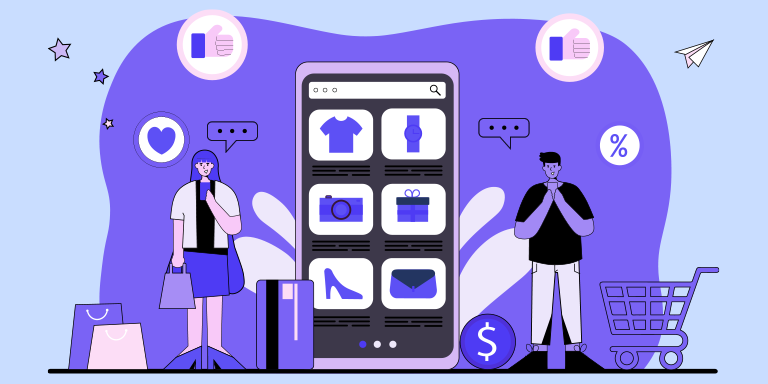By 2028, the global social commerce market is projected to reach $2.9 trillion, growing at a rate of 28.4%. The influence of social media platforms like Instagram and TikTok has been a key driver behind this incredible rise. If you’re looking for strategies to drive direct sales through social media, look no further. It’s time to look at these channels as a profitable sales tool.
Key Takeaways
- 5.07 billion people use social media, totalling an average time of 2h 20m per day! That’s a lot of screen time that you can harness to increase sales.
- There are pros and cons to all social apps – knowing which platforms your target demographic prefers is paramount to a successful social selling campaign.
- Social selling can reduce customer journey friction in the buying process – this helps boost conversion rates and encourages faster (sometimes impulse), purchasing decisions.
How to Sell Directly Through Social Media
Social media has evolved massively – no longer are platforms used to share personal content, but now businesses can sell to customers at any time of the day, in any location around the world. Here’s an overview of the most effective platforms and their tools for social selling:
1. Instagram
130 million users tap on Instagram shopping posts each month to learn more about products, highlighting the effectiveness of shoppable posts for selling your products. 44% of people use Instagram to shop weekly, making it one of the leading platforms for social commerce.
Kylie Cosmetics generated $360 million in revenue within two years of launching attributing more than 25% of their sales to social media. Gymshark, a UK-based gym wear brand has grown into a billion-dollar company largely by utilizing Instagram’s Shoppable Posts to tag their products in influencers’ content, driving sales. Check out these top Instagram analytics to track when launching your commerce campaigns.
- Key Features:
- Instagram Shops: Allows businesses to create a fully branded storefront that is accessible from their profile.
- Shoppable Posts: Tag products in posts to facilitate direct purchases and allow users to purchase products directly from their feed. Easy win!
- Instagram Live Shopping: Sell products during live streams and interact with your customers.
2. TikTok
TikTok is not only a platform for viral content but also a growing space for social selling. Its short-form, highly engaging content drives product discovery, especially through viral challenges and demonstrations. TikTok saw over $1 billion in social selling transactions in 2022, making it a hub for viral marketing trends, with the hashtag #TikTokMadeMeBuyIt gaining massive traction.
- Key Features:
- TikTok Shopping: Brands can integrate their products with the platform, making it easier to engage users with direct sales.
- Shoppable Videos: Drive users to purchase through product tags.
- Influencer Collaboration: Leverage popular creators to showcase products.
3. Facebook
56% of U.S. consumers made a purchase using Facebook last year! Footwear brand, Allbirds reported a 14x return on ad spend across social media platforms in 2020, showing the power of social media advertising in increasing revenue. To learn more, check out this post on Facebook advertising for beginners.
- Key Features:
- Facebook Shops: A customizable, integrated storefront – very similar to Instagram.
- Facebook Marketplace: Ideal for local selling and is user-driven.
- Facebook Live: Live-selling, making it easy to demonstrate products to a large audience in real time.
4. Pinterest
Pinterest is a discovery-focused platform, ideal for brands looking to target users with purchasing intent. It is possible to create native-looking adverts that drive higher conversions and encourage users to save your ‘pins’ to inspiration boards.
Key Features:
- Product Pins: Highlight specific products for sale which link directly to product pages, allowing for a smooth buying journey.
- Pinterest Shopping: Curate boards full of purchasable products.
- Shopping Ads: Promoted product pins to increase visibility that look like native pins, allowing for more subtle integration and increasing your chances of being shared on the platform.
5. LinkedIn
LinkedIn has evolved from a professional B2B networking site into a robust platform for social selling. Its features support businesses and professionals in building relationships, nurturing leads, and driving sales.
Key Features:
- Sales Navigator: Designed specifically for sales professionals, offering advanced search capabilities and lead recommendations.
- Paid ads: LinkedIn offers various advertising options that allow businesses to target based on job titles and company names.
- InMail Messaging: Send messages directly to any LinkedIn member, even if you’re not connected, bypassing the typical connection barriers.
Pros of Social Media Selling
Social media has become a powerful avenue for businesses to reach and engage customers directly. However, like any sales channel, it comes with its own pros and cons.
1. Large, Engaged Audience
Social media platforms like Instagram, Facebook and TikTok boast billions of active users. This vast audience provides businesses with significant opportunities to reach potential buyers and create brand visibility. Brands can reach specific demographics based on age, interests, location, and even behaviors. This enables businesses to target users who are more likely to convert, reducing wasted ad spend and increasing return on investment.
3. Influencer and User-Generated Content
Collaborating with influencers and encouraging user-generated content helps brands leverage the trust and authenticity that comes from recommendations, because people trust people, not businesses.
4. Real-Time Engagement
Social selling allows brands to engage directly with customers in real-time through comments, direct messages, or live-stream events. Businesses can answer questions, provide customer support, and address concerns almost instantly, which helps to build trust and boost conversion rates.
Cons of Social Media Selling
2. Platform Dependency
When selling through social media, businesses are dependent on the platform’s algorithms and rules. Changes in algorithms can reduce your organic reach, and policy updates may affect your ability to sell. There’s also the risk of account suspensions or bans, which could severely impact sales.
3. Customer Privacy Concerns
Social platforms collect and use large amounts of data, and privacy concerns are growing among users. Some consumers are wary of sharing their information or making purchases directly through social platforms due to security or privacy concerns, limiting the number of transactions.
5. Time-Consuming Content Creation
Selling on social media requires a constant stream of engaging, high-quality content to keep your audience interested. Creating this content takes significant time and resources. Small businesses may struggle to keep up with the content demands needed to drive sales.
How to Create Conversion-Focused Content and Optimize The Buyer’s Journey
But all is not lost! Here are some quick conversion-focused content ideas to help drive direct sales on social platforms… It’s important to focus on creating content that not only engages your audience in a very, very crowded marketplace but also prompts conversions. As a rule of thumb, you have about 2 seconds to engage your audience before you get swiped!
- Product Videos: Show how a product works in real-life situations. Demonstrations, how-tos, and unboxing videos are particularly effective. Afterall, everyone wants life-hacks!
- Influencer Marketing: Collaborating with influencers to showcase products in an authentic, relatable way helps build trust with your audiences, prompting immediate purchases and appeals to people’s FOMO!
- User-Generated Content: Sharing is caring… And real customers’ photos and testimonials build social proof, reassuring potential buyers about quality and value. If you want some more information, read this article on the perks of user-generated content.
- Shoppable Stories and Ads: Use shoppable posts, tags, and ads to make it simple for users to find and explore products. A clear CTA in the post can directly lead users to product pages or checkout with just one tap.
- Easy product discovery: Seamless checkout experience: Reduce the number of steps needed to complete a purchase. Features like Instagram Checkout or Facebook Shops allow users to buy products without leaving the app, minimizing distractions and drop-off points.
Tracking and Measuring Success
What gets measured gets improved! By measuring some of the below metrics or key performance indicators (KPIs), you will be able to assess how well your social media sales are performing:
- Customer Acquisition Cost (CAC): Calculate how much it costs to acquire a customer through paid advertising or influencer marketing. Lowering your CAC indicates better efficiency in your campaigns.
- Return on Ad Spend (ROAS): This measures the revenue generated for each dollar spent on ads. A high ROAS shows that your campaigns are effectively driving sales.
- Engagement to Conversion Ratio: Track how well your engagement (likes, comments, shares) translates into actual sales. High engagement doesn’t always mean high conversions, so this ratio helps evaluate content quality in terms of sales potential.
Social media platforms are no longer just about visibility and engagement. They are powerful tools for driving direct sales through features like shoppable posts, live-stream selling, and storefronts. By creating conversion-focused content and optimizing the buyer’s journey, businesses can tap into social commerce to boost revenue. If you want to know more about the power of TikTok and the most important metrics to monitor, give this article a read.
If you are looking for more training, honest business advice and access to over 1000+ online lessons around launching, scaling and marketing your business, why not sign up to Foundr+ for just $1 a month? Get access here. You will find plenty of content and live coaching around how to utilize the power of social media for selling your products and services.
FAQs:
How do I set up my social media account for direct sales?
Ensure you set up a business account to unlock selling features and insights which will make your life so much easier! You could also do things like uploading a product catalog to enable tagging of products in posts and stories. This step is crucial for shoppable content.
What type of content should I create to drive direct sales on social media?
Think about creating content that will engage your customers, but will also make them go, “I WANT THAT PRODUCT, NOW!” Try and create a sense of FOMO through influencer marketing, or life hacks through video content. Include shoppable posts and stories with clear CTAs to eliminate any friction points in their path to purchase.
How do I measure the success of social media selling?
First things first – know your audience. Once you know your audience inside out, you can implement testing and learning to ensure your social selling is optimized and performing well. The KPIs may be different for your brand but, some of the top ones to keep an eye on include: Your conversion rates, cost per acquisition and return on ad-spend.
















